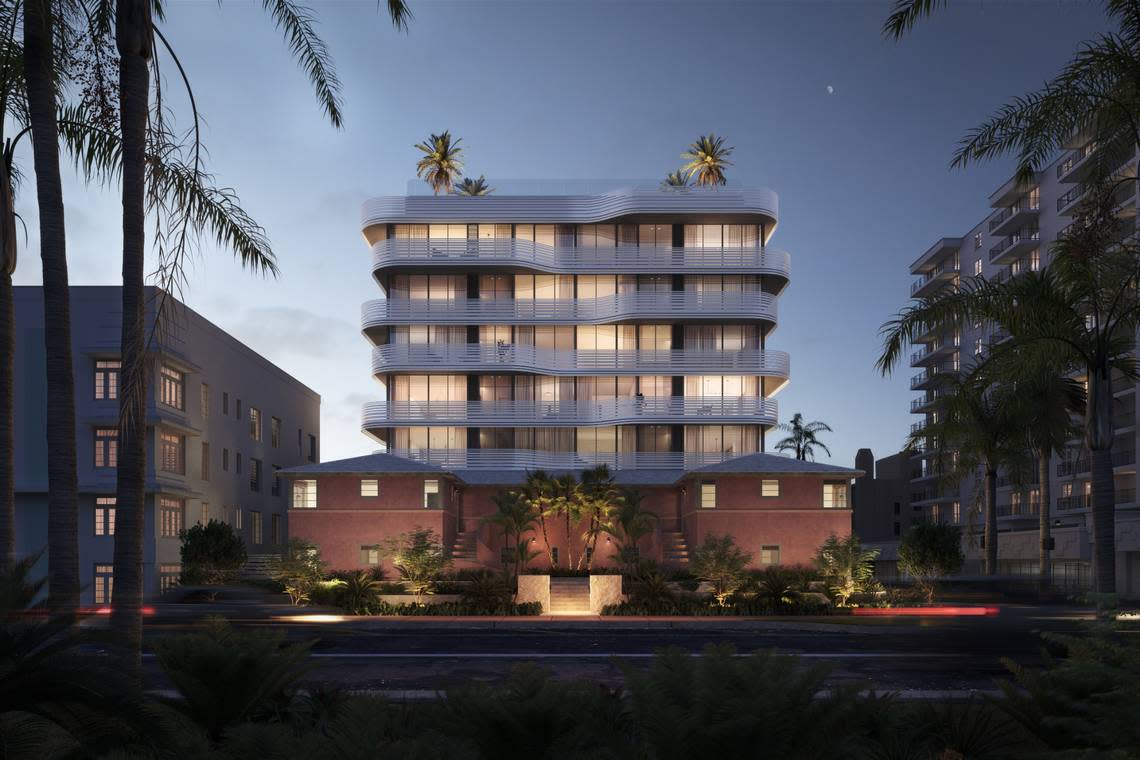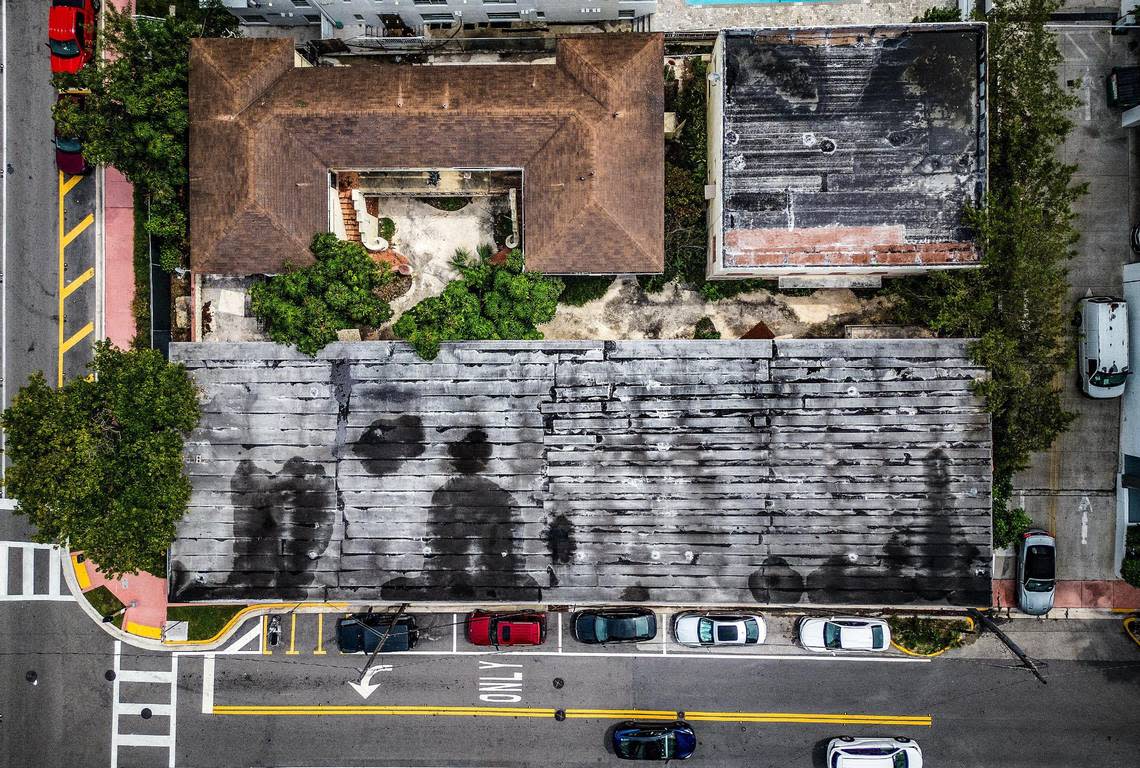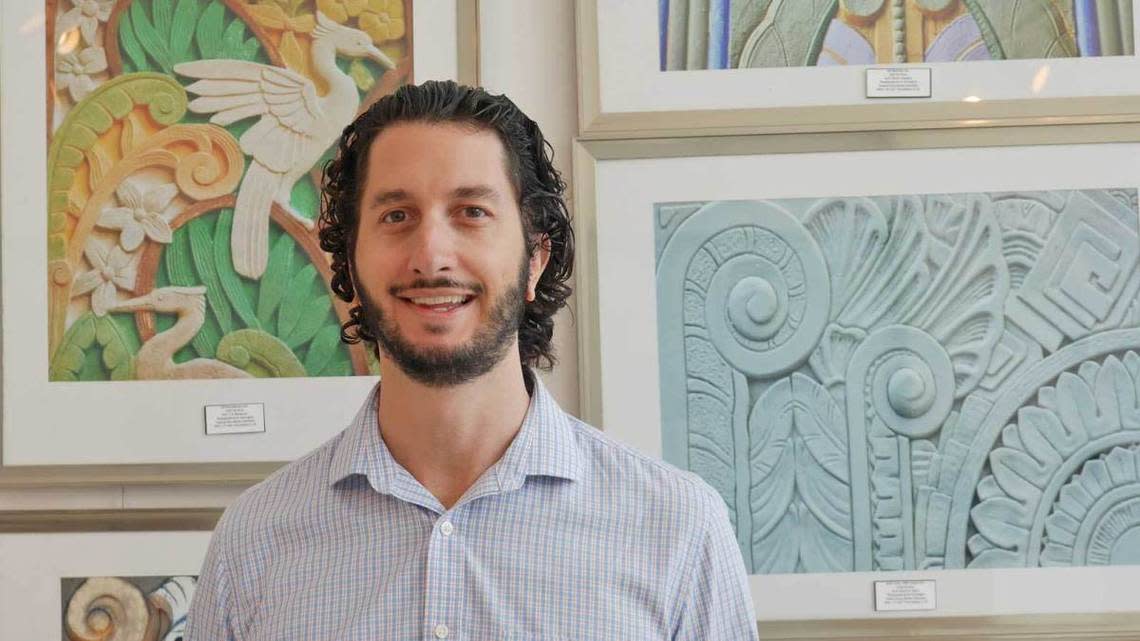Several years ago, Jason Halpern, a New York developer with an affinity for historic buildings and neighborhoods, bought a mid-Miami Beach lot with a dilemma. It came in the shape of two old, architecturally mismatched apartment houses — one from the 1930s and the second from the early 1960s.
From the start, Halpern and his JMH Development, which has won awards for preserving and adapting historic buildings for contemporary use in Brooklyn and Miami Beach, planned a luxury low-rise condominium project. It would combine a portion of the old with a modern addition, an increasingly common approach in the resort city’s numerous historic districts.
Then climate change, and the city’s response to it, forced Halpern back to the drawing board.
And JMH’s new plan for Twenty-Nine Indian Creek, which involves lifting, rotating and fully preserving the two-story 1930s building, is being touted as an object lesson in how creativity and flexibility on the part of developers and city authorities can save vulnerable architectural landmarks and make them far more resilient, while producing a better, even unique, overall project.
In the new scheme, the 1936 building, a graceful blend of traditional Mediterranean design and Art Deco architecture, will become the face of the redevelopment.
“I love that project as a great example of resiliency and preservation,” said Daniel Ciraldo, executive director of the Miami Design Preservation League, a group that promotes protection and public appreciation of the Beach’s historic architecture. “We are really becoming a great laboratory of how we can make our historic neighborhoods resilient.”

Supporters of preservation say Halpern’s example is especially pertinent in the wake of a battle over a pair of bills filed during this year’s session of the Florida Legislature that could have effectively wiped out protections for thousands of historic buildings in flood zones across the state, including much of Miami Beach.
The bills, which advanced rapidly at first before dying following a statewide outcry and detailed coverage in the Miami Herald, would have allowed owners of buildings along the coast to demolish them for any reason, even if protected as historic landmarks by local rules, ostensibly so they could be replaced by flood-resistant new buildings. Legislative sponsors have said they will bring the legislation back next year.
But city officials and preservation activists contend that Twenty-Nine Indian Creek, along with several other high-profile restoration projects now underway across the Beach, demonstrate that tearing down historic buildings is not the best response to the challenges posed by sea-level rise.
Instead, they argue, having protections and a regulatory process like Miami Beach’s that foster public input and innovation in deciding the fate of historic buildings benefits developers as well as the broader community, which sees history, neighborhood character and property values preserved and enhanced.
“In New York, neighborhoods get butchered by new development when there are no protections,” Halpern said. “Our goal is to restore a building and get economic benefits from it. It’s definitely more complicated. But a building with character should definitely enhance the appeal of a project.”
Preservation leading modernization
Other developers might have shied away from the corner property along Indian Creek Drive as too much of a headache, even though it’s an appealing location. It’s on a block wedged between the waterway and Collins Avenue, which runs along the Atlantic Ocean and the city’s famed beaches.
A couple of blocks away are two widely praised examples of historic preservation and modernization — hotelier Ian Schrager’s Miami Beach Edition, a deluxe restoration of the historic Seville Hotel, and developer Alan Faena’s namesake district, which includes two revamped historic hotels, a new cultural center and a new ultraluxury condo tower.
Like the Edition and the Faena District, JMH’s property sits in a designated historic neighborhood, so that the buildings on it were protected by the city’s strict preservation law and its historic preservation board, which zealously guards Miami Beach’s architectural legacy.
But that was precisely the appeal for Halpern and JMH, which specializes in adapting historic buildings as well as in constructing new ones in the protected environment of historic neighborhoods, reaping a profit by leveraging their unique architectural character. Properties in historic neighborhoods tend to retain their value and usually see higher price increases than those in newer areas, Halpern said.
On the Brooklyn waterfront, for instance, JMH converted a massive 1913 warehouse designed by Cass Gilbert, architect of the U.S. Supreme Court building, into a luxury apartment complex. On Indian Creek in South Beach, JMH revamped the historic Motel Ankara and added a mid-rise expansion behind it to create the Hotel Aloft South Beach. In 2016, JMH sold the Aloft for $105 million to a Boston investment group, which renamed it The Gates.
Historic designation reduces competition for a property, Halpern said, because most developers prefer to demolish everything and start from scratch. And a background in construction and his experience with preservation and its advantages — such as the ability to reap federal tax credits on commercial projects — gives him a leg up, Halpern said.

“It narrows the field,” he said. “Anybody could go look at a site just for land. But I understand the preservation process. I understand who to work with. You have to feel comfortable with your skill set when you have an existing structure, to make it aesthetically correct.
“When not everyone is doing the same thing, it’s more interesting.”
Halpern is not the only developer mining historic properties in the vicinity.
Next to Faena House, the sleekly modern tower whose condos broke local price records, developers plan to save another historic Art Deco treasure, the long-vacant Versailles Hotel tower from 1941, by completely rebuilding its interior, including all structural elements, to meet modern construction code. Next to it, on a lot where a 1955 addition to the Versailles was torn down, a new luxury 18-story condo tower will rise under the plan, approved by the city preservation board in 2021. The property will be rebranded as Aman Miami Beach.
But the corner site for Twenty-Nine Indian Creek, which Miami-Dade County records show Halpern and partners bought in 2017 for $7.75 million, was a special challenge. Not the least of it is the glaring fact that it sits on a sliver of land between Indian Creek, which is part of the Intracoastal Waterway, and the ocean.
The four-unit apartment building from 1936, designed by Carlos Schoeppel, a prominent Beach architect responsible for many of the city’s original Mediterranean mansions, is set well back from the corner facing south.
In 1962, a two-story, L-shaped apartment building was put up across the front of the Schoeppel building, almost completely obscuring it from view, and filling the rest of the lot. The newer building, though plain, displays some elements of what later came to be known as Miami Modern, or MiMo, architecture.
The buildings, which sit within the designated Collins Waterfront Historic District, were both protected as “contributing” structures because their disparate architectural styles demonstrate how the neighborhood evolved over decades.
Because Halpern needed space to build more units in a modern addition, he proposed tearing down a portion of the 1962 building, while restoring and preserving the rest. The entire 1936 building was to be restored in its original location.
The city historic board approved, balancing its reluctance to allow demolition of a historic structure against the benefits of seeing the rest restored along with an enhanced economic use of the property.

But then the COVID-19 pandemic, and a legal dispute between Halpern and his financial partners, intervened. Halpern prevailed in court against his now-former partners.
Redoing project to offset flood risk
In the meantime, though, the city raised Indian Creek Drive and rebuilt its bulkhead at a higher level as part of an ambitious plan to prepare the low-lying city for rising seas and increased hurricane storm surge.
That meant that JMH’s property, and its two buildings, now sit below the level of the roadway, making the site even more vulnerable than before to flooding.
To salvage his project, Halpern and his architects at Urban Robot Associates, a Miami design firm, entirely redrew the blueprint, working with city preservation chief Deborah Tackett to refine it before presenting it to the preservation board, which has approval authority over development projects in designated historic sites.

The new plan calls for tearing down the entire 1962 building while lifting and turning the Schoeppel building to the west so that it fronts on Indian Creek, revealing its facade to the public for the first time in decades. The 1936 structure would be raised above base flood elevation to meet FEMA standards. Inside, the original four apartments would be converted into a pair of two-story townhomes, Halpern said.
Behind it would rise a new, separate 75-foot condo building — the maximum height allowed by local zoning — in a streamlined modern style that echoes Miami Beach’s tropical version of Deco architecture.
The city preservation office and Miami Design Preservation League, the Beach preservation group, endorsed the idea. So did the city preservation board. Halpern described the process as collaborative.
“They loved the idea,” Halpern said of the advocates and officials. “They are extremely smart and understanding. They’re open-minded and understand the process really well. It’s a nice case of Miami Beach historic preservation working with a developer, showing flexibility and coming back with thoughtful suggestions and getting to a conclusion quickly.”
Although the new version of the project entails significantly more demolition than the old, the city preservation board recognized that it represents a needed and imaginative response to the flooding dilemma, Tackett said.
“It’s a fantastic project,” she said in an interview. “Miami Beach is not a museum city. We are not scared of creative solutions even with historic buildings.”
To be sure, some leading preservation activists have vocally criticized the city for allowing even partial demolition of some historic structures to accommodate redevelopment.

City that evolves
But Ciraldo, the Miami preservation league director, said the city’s approach is the right one, ensuring economic vitality and a renewed future life for historic buildings.
“Yes, there will be some loss of historic buildings, but given the reality of Indian Creek, this is a positive example,” Ciraldo said of Halpern’s plan. “All of this speaks to the fact that Miami Beach is not a frozen-in-time kind of place. It’s a place that evolves.”
Ciraldo also commended Halpern and city officials for ensuring the addition be modern in style yet sympathetic to Schoeppel’s building, avoiding architectural mimicry while making the structures “distinct and compatible,” to use the language in city guidelines.
“If this were Colonial Willamsburg, it might be a different matter. Maybe traditional preservationists would disagree,” Ciraldo said. “When you build something new, it should be of its time. We shouldn’t be building Disney World in South Beach.”
